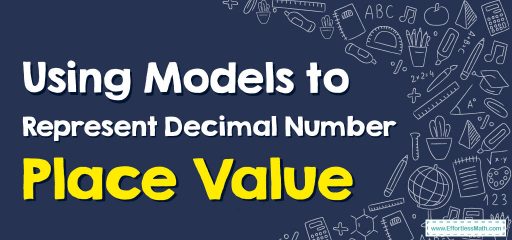Using Models to Represent Decimal Number Place Value
Here you will learn more about the decimal place value chart.
The chart tells us about the positions of numbers after the decimal point.

The first position on the right side of the decimal point is called the “tenths” place, the second position is called the “hundredths” place, and the third position is called the “thousandths” place.
We can find these positions by dividing the number by 10, 100, and 1000, respectively.
The Absolute Best Book for 4th Grade Students
A step-by-step guide to using models to represent decimal number place value
Here is a step-by-step guide to using models to represent decimal number place values:
- First, you need to understand the concept of place value. In a decimal number, each digit has a specific place value determined by its position in the number. The digits to the left of the decimal point represent whole numbers, while the digits to the right of the decimal point represent fractions or parts of a whole.
- Next, you can use a visual model to represent the place value of each digit. One common model is a place value chart, which is a table that lists the place value of each digit in a number. For example, the chart might show that the first digit to the right of the decimal point represents tenths, the second digit represents hundredths, the third digit represents thousandths, and so on.
- Another visual model that you can use is a decimal grid. This is a grid that is divided into equal parts to represent the whole number and the decimal parts. Each part of the grid represents a specific value depending on the number of equal parts in the grid.
- To represent a specific decimal number using a model, you can use the place value chart or decimal grid to show the value of each digit. For example, to represent the number 0.53 using a decimal grid, you can divide the grid into 10 equal parts, with each part representing 0.1, and then shade 5 parts to represent 0.5. Then, divide each part into 10 smaller parts to represent 0.01 and shade 3 of those to represent 0.03, which gives you a total value of 0.53.
- By using models to represent the place value of each digit in a decimal number, you can better understand the value and relationship between each digit, which can help you perform calculations and solve problems more effectively.
The Best Math Books for Elementary Students
Related to This Article
More math articles
- How to Solve a Quadratic Equation? (+FREE Worksheet!)
- How to Add and Subtract Integers: Word Problems
- How to Understand the Nuance of Equality of Vectors in Two Dimensions
- Students Make the Most Mistakes in These Math Topics
- 10 Tips for Advanced Studying Mathematics
- 12 Tools Math Students Love When It Comes to Essay Writing
- How to Study Math Effectively in College?
- How to Master Polynomial Functions: A Comprehensive Guide to Understanding and Solving Complex Zeros
- How to Solve One-Step Equations? (+FREE Worksheet!)
- Full-Length SSAT Lower Level Math Practice Test













What people say about "Using Models to Represent Decimal Number Place Value - Effortless Math: We Help Students Learn to LOVE Mathematics"?
No one replied yet.